Scotland's Labour Market: People, Places, and Regions - Statistics from the Annual Population Survey 2019
Summary publication of results from the Annual Population Survey 2019, presenting analysis on the labour market, education and training.
Section 5: Inactivity
5.1 Inactivity over time
Scotland's inactivity rate in 2019 was above the rate for the UK.
The inactivity rate for those aged 16-64 in Scotland in 2019 was 22.5 per cent, slightly higher than the UK rate of 21.2 per cent.
Over the year, the rate has decreased marginally in Scotland (down 0.1 percentage points) and the UK (down 0.4 percentage points).
Scotland's inactivity rate is slightly lower in 2019 compared with 2009 (0.1 percentage points) ,while in the UK the inactivity rate is 2.3 percentage points lower.
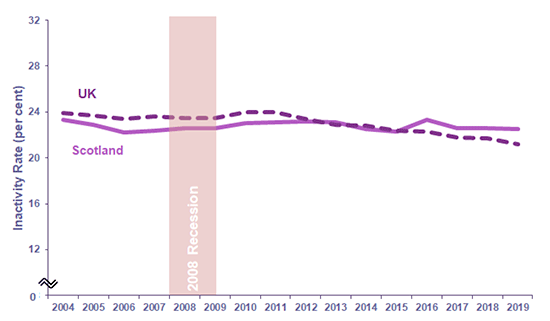
Who is classed as economically inactive?
Individuals aged 16 to 64 who are neither employed nor unemployed under ILO definitions are classed as economically inactive. There are many reasons why people may be inactive and not considered an active part of the labour supply: they may have a long-term illness or disability, be studying for a qualification, staying at home to look after their family, or have retired.
Inactivity rate is higher for women (16 to 64 years) at 25.9 per cent compared with 18.9 per cent for men.
Overall women account for 59.0 per cent of economically inactive people (16 to 64).
5.2 Gender and age
While the inactivity rate has decreased for women in Scotland since 2009 it has increased for men.
The inactivity (16 to 64) rate for women in Scotland decreased by 0.9 percentage point from 26.7 per cent in 2018 to 25.9 per cent in 2019.
Over the same period the inactivity rate for men increased slightly by 0.6 percentage points (18.2 per cent to 18.9 per cent).
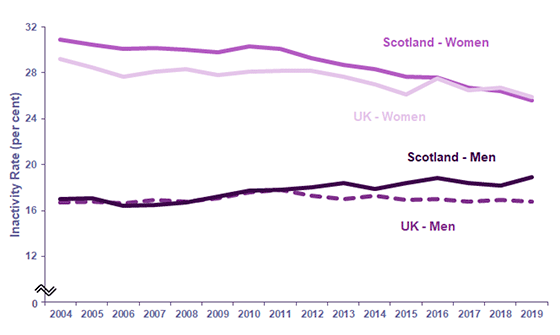
Economic inactivity rates, since 2009, have increased for the younger age bands 16 to 24 years mainly due to full-time education increases and decreased for those aged 50 to 64.
Economic inactivity rates for 25 to 34 year olds have remained around 15 per cent from 2004 to 2019 as has the economic inactivity rates for 35 to 49 year olds, although the latter was slightly higher in 2016 and 2017 than 2019.
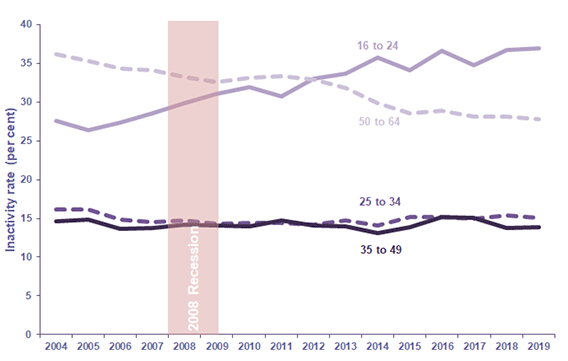
5.3 Reasons for Inactivity
Over 53.7 per cent of the 773,000 economically inactive people (16 to 64) in Scotland were inactive because they were long-term sick or students.
Of the 773,000 economically inactive people (16 to 64) in 2019, the main reasons for being inactive were having long-term sickness or disability (217,500, 28.1 per cent) and student (197,400, 25.5 per cent).
Around one quarter (23.9 per cent) of all inactive people aged 16 to 64 years are in full time education, the majority of whom are aged 16 to 24 years old.
Increase in economic inactivity levels since 2009 was driven by increases in the number of students.
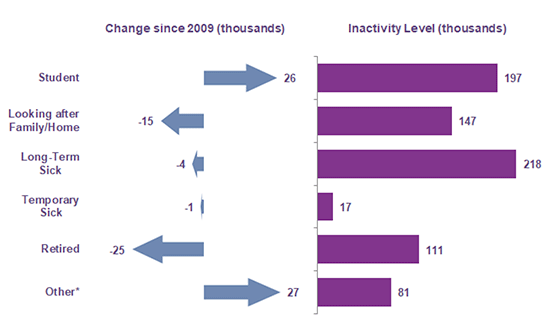
Economic inactivity levels (16 to 64) in Scotland have increased by 6,100 since 2009. This has been driven mainly by a 25,600 increase in the number of students who were inactive as well as those who gave 'Other' as the reason for being inactive (up 26,700).
Whereas since 2009, decreases have been in those looking after family or home, decreasing by 15,200; long-term sick decreased by 3,700.
Reasons for inactivity differ by gender with looking after family/home accounting for 6.6 per cent of inactive men, but 27.7 per cent of inactive women.
Long-term sick and temporary sick accounted for 37.2 per cent of inactive men, but just 25.4 per cent of inactive women.
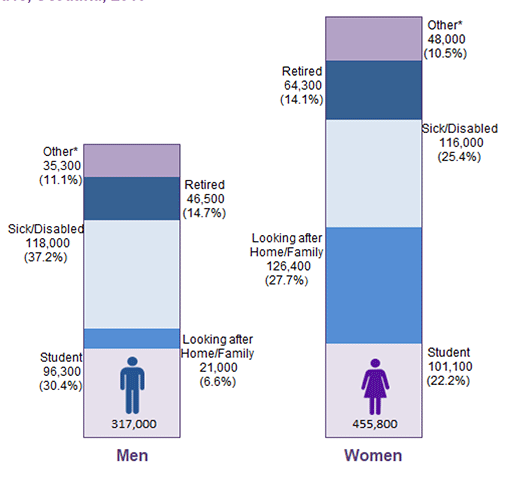
* “Other” reasons for inactivity include: “Other”, “No reason given”, and “Waiting on the result of a job application”.
5.4 Local authorities
There is considerable variation in inactivity rates for those aged 16 to 64 across Scotland's local authorities.
In 2019, the highest economic inactivity rates were seen in:
- Glasgow City (29.3 per cent);
- Inverclyde (27.8 per cent); and,
- Dundee City (27.2 per cent).
The lowest rates were seen in:
- Perth and Kinross (14.7 per cent),
- Na h-Eileanan Siar (16.7 per cent); and,
- Aberdeenshire (17.0 per cent).
Since 2018, economic inactivity rates decreased in 17 of the 32 local authority areas while 13 saw an increase in their inactivity rates (there is no data** for Orkney Islands and Shetland Islands).
The only statistically significant decrease was seen in:
- Perth and Kinross (down 4.4*percentage points from 19.1 per cent to 14.7 per cent).
The only statistically significant increase was seen in:
- Inverclyde (up 5.2* percentage points from 22.6 per cent to 27.8 per cent).
Since 2009, economic inactivity rates increased in 16 of the 32 local authority areas while 14 saw a decrease in their inactivity rates.
The only statistically significant increase was seen in:
- Moray (up 4.1* percentage points from 18.0 per cent to 22.1 per cent).
The only statistically significant decrease was seen in:
- Perth and Kinross (down 6.8* percentage points from 21.4 per cent to 14.7 per cent).
It should be noted that economic inactivity rates in university cities are likely to be higher due to higher levels of economically inactive students.
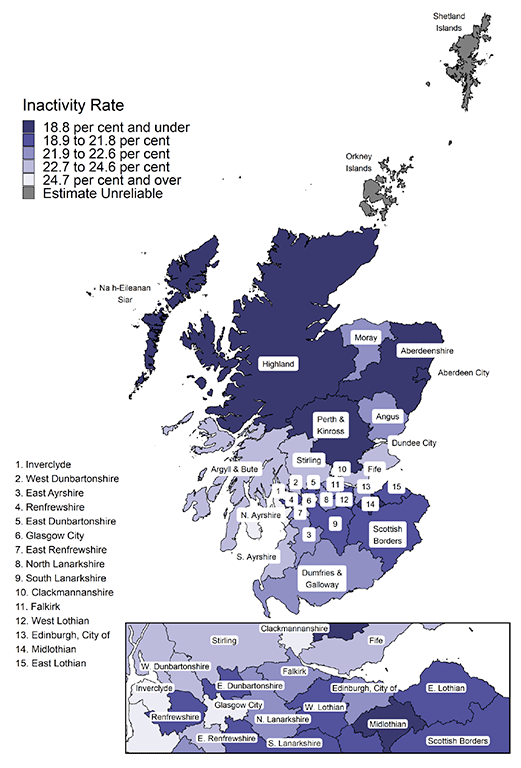
* Statistically Significant
** Estimates are below reliability threshold or disclosive.
5.5 Want to Work
20.4 per cent (157,800) of economically inactive people aged 16 to 64 in Scotland would like to work but were currently unable to do so, the lowest percentage in the series.
The proportion of those who were economically inactive but who wanted to work has decreased since 2013, having previously been on an upward trend since 2010.
Since 2009, the proportion of those who were economically inactive who would like a job decreased by 5.4 percentage points from 25.8 per cent in 2009 to 20.4 per cent in 2019.
The percentage of economically inactive who would like to work decreased for both men and women. Although it is lower for women at 19.6 per cent compared with 21.6 per cent for men.
Regional Differences
Data are not available for local authorities11: Clackmannanshire, Falkirk, Midlothian, Orkney Islands, Perth and Kinross, Scottish Borders. Shetland Islands, and South Lanarkshire.
In 2019, the local authorities with the highest proportion of economically inactive people who would like to work were:
- Na h-Eileanan Siar (34.4 per cent);
- North Ayrshire (30.1 per cent); and,
- Angus (29.0 per cent).
The lowest proportions were seen in:
- Stirling (12.9 per cent);
- East Dunbartonshire (15.1 per cent); and,
- West Dunbartonshire (15.7 per cent).
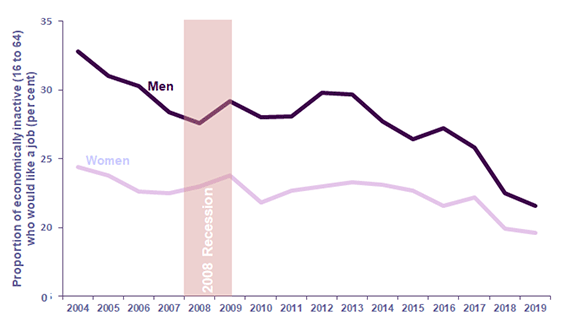
5.6 Never worked
148,500 people in Scotland in 2019 have never worked (excluding 16 to 24 year old students in full-time education).
In 2019, 305,500 people in Scotland aged 16 and over have never worked, a decrease of 14,800 over the year. Just over half of the people in Scotland who have never worked were 16 to 24 year olds in full-time education.
Excluding 16 to 24 year olds in full-time education, there were 148,500 people in Scotland who have never worked; a decrease of 11,700 over the year.
Since 2009, the number of people who have never worked including and excluding 16 to 24 year old students in full-time education has increased by 59,300 and 34,500, respectively.
Regional Differences
Since 2009, reductions in the number of people who have never worked were seen across 8 local authority areas with 20 seeing increases. No information is available** for: Clackmannanshire, Na h-Eileanan Siar, Orkney Islands and Shetland Islands.
The largest increases in the number of people who have never worked since 2009 were seen in:
- City of Edinburgh (up 18,000 to 40,800),
- North Lanarkshire (up 13,600 to 24,900); and,
- South Lanarkshire (up 4,700 to 14,200).
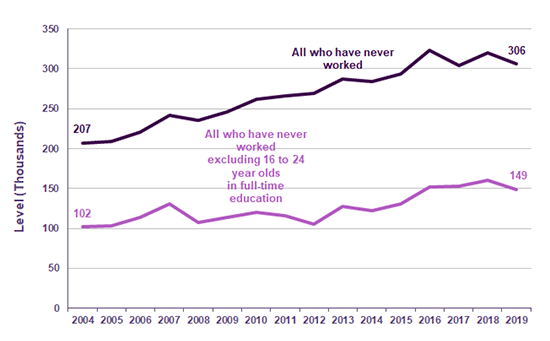
* Statistically Significant
** Estimates are below reliability threshold or disclosive.
Contact
Email: LMStats@gov.scot
There is a problem
Thanks for your feedback